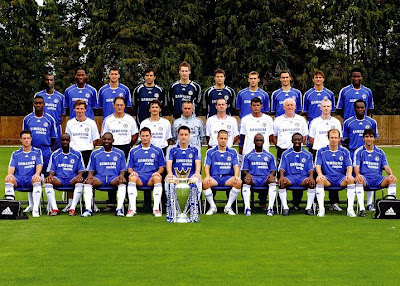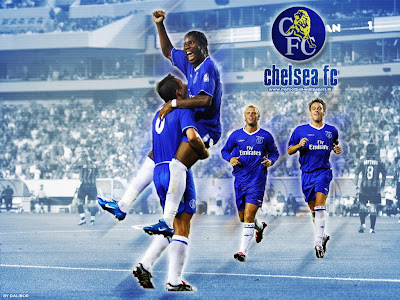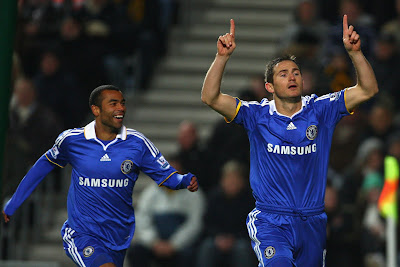Chelsea Football Club is an English football club based in west London. Founded in 1905, they play in the Premier League and have spent most of their history in the top tier of English football. Chelsea have been English champions four times, FA Cup winners six times and League Cup winners four times. They have also been successful in Europe, winning the UEFA Cup Winners' Cup twice. The club had their first major success in 1955, when they won the league championship. Chelsea won several cup competitions during the 1960s and 1970s, but after that did not win another major title until 1997. The past decade has been the most successful period in Chelsea’s history, capped by winning Premier League titles in 2005, 2006 and 2010, and reaching their first UEFA Champions League final in 2008.
Despite their name, the club are not based in Chelsea, but in neighbouring Fulham. The club's home is the 41,841 capacity Stamford Bridge football stadium in Fulham, where they have played since their establishment. In 2003, they were bought by Russian oil magnate Roman Abramovich. Chelsea's regular kit colours are royal blue shirts and shorts with white socks, the combination used since the 1960s. The club crest has been changed several times in attempts to modernise or re-brand; the current crest, featuring a ceremonial lion holding a staff, is a modified version of one first adopted in the 1950s. The club has sustained the fifth highest average all-time attendance in English football. Their average home gate for the 2009–10 season was 41,423, the fifth highest in the Premier League.
Chelsea were founded on 10 March 1905 at The Rising Sun pub (now The Butcher's Hook), opposite the present-day main entrance to the ground on Fulham Road, and were elected to the Football League shortly afterwards. The club's early years saw little success; the closest they came to winning a major trophy was reaching the 1915 FA Cup Final, where they lost to Sheffield United. Chelsea gained a reputation for signing big-name players and for being entertainers, but made little impact on the English game in the inter-war years. Former Arsenal and England centre-forward Ted Drake became manager in 1952 and proceeded to modernise the club. He removed the club's Chelsea pensioner crest, improved the youth set-up and training regime, rebuilt the side, and led Chelsea to their first major trophy success — the League championship — in 1954–55.
Chelsea were founded on 10 March 1905 at The Rising Sun pub (now The Butcher's Hook), opposite the present-day main entrance to the ground on Fulham Road, and were elected to the Football League shortly afterwards. The club's early years saw little success; the closest they came to winning a major trophy was reaching the 1915 FA Cup Final, where they lost to Sheffield United. Chelsea gained a reputation for signing big-name players and for being entertainers, but made little impact on the English game in the inter-war years. Former Arsenal and England centre-forward Ted Drake became manager in 1952 and proceeded to modernise the club. He removed the club's Chelsea pensioner crest, improved the youth set-up and training regime, rebuilt the side, and led Chelsea to their first major trophy success — the League championship — in 1954–55.
The following season saw UEFA create the European Champions' Cup, but after objections from The Football League and the FA Chelsea were persuaded to withdraw from the competition before it started. They challenged for honours throughout the 1960s, and endured several near-misses. They were on course for a treble of League, FA Cup and League Cup going into the final stages of the 1964–65 season, winning the League Cup but faltering late on in the other two. In three seasons the side were beaten in three major semi-finals and were FA Cup runners-up. Chelsea won the FA Cup in 1970, beating Leeds United 2–1 in a final replay. Chelsea took their first European honour, a UEFA Cup Winners' Cup triumph, the following year, with another replayed win, this time over Real Madrid in Athens.
The late 1970s through to the 1980s was a turbulent period for Chelsea. An ambitious redevelopment of Stamford Bridge threatened the financial stability of the club, star players were sold and the team were relegated. Further problems were caused by a notorious hooligan element among the support, which was to plague the club throughout the decade. In 1982 Chelsea were, at the nadir of their fortunes, acquired by Ken Bates for the nominal sum of £1, although by now the Stamford Bridge freehold had been sold to property developers, meaning the club faced losing their home. On the pitch, the team had fared little better, coming close to relegation to the Third Division for the first time, but in 1983 manager John Neal put together an impressive new team for minimal outlay.
Chelsea won the Second Division title in 1983–84 and established themselves in the top division, before being relegated again in 1988. The club bounced back immediately by winning the Second Division championship in 1988–89. After a long-running legal battle, Bates reunited the stadium freehold with the club in 1992 by doing a deal with the banks of the property developers, who had been bankrupted by a market crash. Chelsea's form in the new Premier League was unconvincing, although they did reach the 1994 FA Cup Final. It was not until the appointment of former European Footballer of the Year Ruud Gullit as player-manager in 1996 that their fortunes changed. He added several top-class international players to the side, as the club won the FA Cup in 1997 and established themselves as one of England's top sides again.
Gullit was replaced by Gianluca Vialli, who led the team to victory in the League Cup Final and the Cup Winners' Cup Final in 1998, the FA Cup in 2000 and the UEFA Champions League quarter-finals in 2000. Vialli was sacked in favour of another Italian, Claudio Ranieri, who guided Chelsea to the 2002 FA Cup Final and Champions League qualification in 2002–03. In June 2003, Bates sold Chelsea to Russian billionaire Roman Abramovich for £140 million, completing what was then the biggest-ever sale of an English football club. Over £100 million was spent on new players, but Ranieri was unable to deliver any trophies, so he was replaced by Portuguese coach José Mourinho. Under Mourinho, Chelsea became the fifth English team to win back-to-back league championships since the Second World War (2004–05 and 2005–06), in addition to winning an FA Cup (2007) and two League Cups (2005 and 2007).
In September 2007 Mourinho was replaced by Avram Grant, who led the club to their first UEFA Champions League final, which they lost on penalties to Manchester United. Grant was fired days later and succeeded by Luiz Felipe Scolari in July 2008. Scolari spent only seven months in the job before being dismissed after a string of poor results. Russia coach Guus Hiddink was appointed caretaker manager until the end of the 2008–09 season, and guided Chelsea to a second FA Cup triumph in three years. Two days later former Milan coach Carlo Ancelotti was confirmed as Chelsea's new manager. In his first season, Ancelotti led Chelsea to their first league and FA Cup "Double"; in addition, Chelsea became the first English top-flight side to score over 100 league goals in a season since 1963.
Since the club's foundation, Chelsea have had four main crests, though all underwent minor variations. In 1905, Chelsea adopted as their first crest the image of a Chelsea pensioner, which obviously contributed to the "pensioner" nickname, and remained for the next half-century, though it never appeared on the shirts. As part of Ted Drake's modernisation of the club from 1952 onwards, he insisted that the pensioner badge be removed from the match day programme in order to change the club's image and that a new crest be adopted. As a stop-gap, a temporary emblem comprising simply the initials C.F.C. was adopted for one year. In 1953, Chelsea's crest was changed to an upright blue lion looking backwards and holding a staff, which was to endure for the next three decades.
This crest was based on elements in the coat of arms of the Metropolitan Borough of Chelsea[34] with the "lion rampant regardant" taken from the arms of then club president Viscount Chelsea and the staff from the Abbots of Westminster, former Lords of the Manor of Chelsea. It also featured three red roses, to represent England, and two footballs. This was the first club badge to appear on shirts, since the policy of putting the crest on the shirts was only adopted in the early 1960s. In 1986, with Ken Bates now owner of the club, Chelsea's crest was changed again as part of another attempt to modernise and to capitalise on new marketing opportunities. The new badge featured a more naturalistic non-heraldic lion, yellow and not blue, standing over the C.F.C. initials. It lasted for the next 19 years, with some modifications such as the use of different colours.
With new ownership, and the club's centenary approaching, combined with demands from fans for the club's traditional badge to be restored, it was decided that the crest should be changed again in 2004. The new crest was officially adopted for the start of the 2005–06 season and marks a return to the older design of the blue heraldic lion holding a staff. As with previous crests, this one has appeared in various colours, including white and gold. Chelsea have always worn blue shirts, although they initially adopted a lighter shade than the current version, and unlike today wore white shorts and dark blue socks. The lighter blue was taken from the racing colours of then club president, Earl Cadogan. The light blue shirts were short-lived, however, and replaced by a royal blue version in around 1912.
When Tommy Docherty became manager in the early 1960s he changed the kit again, adding blue shorts (which have remained ever since) and white socks, believing it made the club's colours more distinctive, since no other major side used that combination; this kit was first worn during the 1964–65 season. Since then Chelsea have always worn white socks with their home kit apart from a short spell from 1985 to 1992, when blue socks were reintroduced. Chelsea's traditional away colours are all yellow or all white with blue trim, but, as with most teams, they have had some more unusual ones. The first away strip consisted of black and white stripes and for one game in the 1960s the team wore Inter Milan-style blue and black stripes, again at Docherty's behest.
Other memorable away kits include a mint green strip in the 1980s, a red and white checked one in the early 90s and a graphite and tangerine edition in the mid-1990s. Chelsea's kit is currently manufactured by Adidas, which is contracted to supply the club's kit from 2006 to 2011. Previously, the kit was manufactured by Umbro (1968–81), Le Coq Sportif (1981–86), The Chelsea Collection (1986–87) and Umbro again (1987–2006). Chelsea's first shirt sponsor was Gulf Air, agreed midway through the 1983–84 season. Following that, the club were sponsored by Grange Farms, Bai Lin Tea and Italian company Simod before a long-term deal was signed with computer manufacturer Commodore International in 1989; Amiga, an off-shoot of Commodore, also appeared on the shirts. Chelsea were subsequently sponsored by Coors beer (1995–97), Autoglass (1997–2001) and Emirates Airline (2001–05). Chelsea's current shirt sponsor is Samsung who took over the sponsorship from their mobile division in 2007–08.
Since the club's foundation, Chelsea have had four main crests, though all underwent minor variations. In 1905, Chelsea adopted as their first crest the image of a Chelsea pensioner, which obviously contributed to the "pensioner" nickname, and remained for the next half-century, though it never appeared on the shirts. As part of Ted Drake's modernisation of the club from 1952 onwards, he insisted that the pensioner badge be removed from the match day programme in order to change the club's image and that a new crest be adopted.
As a stop-gap, a temporary emblem comprising simply the initials C.F.C. was adopted for one year. In 1953, Chelsea's crest was changed to an upright blue lion looking backwards and holding a staff, which was to endure for the next three decades. This crest was based on elements in the coat of arms of the Metropolitan Borough of Chelsea[34] with the "lion rampant regardant" taken from the arms of then club president Viscount Chelsea and the staff from the Abbots of Westminster, former Lords of the Manor of Chelsea. It also featured three red roses, to represent England, and two footballs. This was the first club badge to appear on shirts, since the policy of putting the crest on the shirts was only adopted in the early 1960s. In 1986, with Ken Bates now owner of the club, Chelsea's crest was changed again as part of another attempt to modernise and to capitalise on new marketing opportunities.
The new badge featured a more naturalistic non-heraldic lion, yellow and not blue, standing over the C.F.C. initials. It lasted for the next 19 years, with some modifications such as the use of different colours. With new ownership, and the club's centenary approaching, combined with demands from fans for the club's traditional badge to be restored, it was decided that the crest should be changed again in 2004. The new crest was officially adopted for the start of the 2005–06 season and marks a return to the older design of the blue heraldic lion holding a staff. As with previous crests, this one has appeared in various colours, including white and gold. Chelsea have always worn blue shirts, although they initially adopted a lighter shade than the current version, and unlike today wore white shorts and dark blue socks. The lighter blue was taken from the racing colours of then club president, Earl Cadogan.
The light blue shirts were short-lived, however, and replaced by a royal blue version in around 1912. When Tommy Docherty became manager in the early 1960s he changed the kit again, adding blue shorts (which have remained ever since) and white socks, believing it made the club's colours more distinctive, since no other major side used that combination; this kit was first worn during the 1964–65 season. Since then Chelsea have always worn white socks with their home kit apart from a short spell from 1985 to 1992, when blue socks were reintroduced. Chelsea's traditional away colours are all yellow or all white with blue trim, but, as with most teams, they have had some more unusual ones.
The first away strip consisted of black and white stripes and for one game in the 1960s the team wore Inter Milan-style blue and black stripes, again at Docherty's behest. Other memorable away kits include a mint green strip in the 1980s, a red and white checked one in the early 90s and a graphite and tangerine edition in the mid-1990s. Chelsea's kit is currently manufactured by Adidas, which is contracted to supply the club's kit from 2006 to 2011. Previously, the kit was manufactured by Umbro (1968–81), Le Coq Sportif (1981–86), The Chelsea Collection (1986–87) and Umbro again (1987–2006). Chelsea's first shirt sponsor was Gulf Air, agreed midway through the 1983–84 season.
Following that, the club were sponsored by Grange Farms, Bai Lin Tea and Italian company Simod before a long-term deal was signed with computer manufacturer Commodore International in 1989; Amiga, an off-shoot of Commodore, also appeared on the shirts. Chelsea were subsequently sponsored by Coors beer (1995–97), Autoglass (1997–2001) and Emirates Airline (2001–05). Chelsea's current shirt sponsor is Samsung who took over the sponsorship from their mobile division in 2007–08.
Chelsea Football Club's Tiger
Chelsea Football Club
Chelsea Football Club
Chelsea Football Club
Chelsea Football Club Team
Chelsea FC The Champions
Chelsea FC Flage
Chelsea FC HD Wallpaper
Chelsea FC LOGO
Chelsea FC Pack
Chelsea FC
Chelsea FC Players
Chelsea FC
Chelsea FC Shirts
Chelsea Football Club Shirt
Chelsea Football Club
Chelsea Football Club
Chelsea Football Club Stadium
Chelsea Football Club
Chelsea Football Club
Chelsea Football Club
Chelsea Football Club's Star Frank Lampard







































